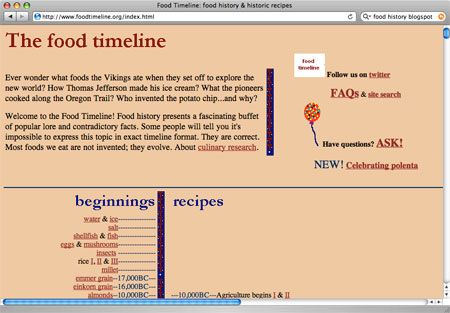Food History on the Web

Once the domain of anthropologists, archeologists, and amateur and professional food writers, the study of food and its relationship to our past has become a fruitful field of inquiry for historians in recent years. A quick check of recently published books and articles reveals hundreds of titles related to food and foodways. Burgeoning interest in food in its historical contexts has opened doors to new and interesting primary sources, leading to a proliferation of specialized archives. Surprisingly, the Web has not kept pace with these new directions in research and expanded archival offerings. Searching the Internet for food-related history sites finds the cupboard quite bare.
While Google searches of food-related history yield impressive statistical results, the content of those searches is less than impressive. Using a variety of search terms, one seemingly finds a tremendous variety of food history Websites—anywhere from a few thousand sites to multiple millions of hits—yet clicking through to these sites reveals little of value for the serious researcher. Most of the relevant sites, and even the most highly ranked hits, are geared toward and/or written by K-8 students, such as “Social Studies for Kids” or “Food of Nineteenth-century United States” or are promotional sites for books written by food writers (e.g.,Infibeam.com). The student-generated sites offer a unique comment on the proliferation and importance of food studies, proving that the field is rich with teaching possibilities. However, the sites themselves offer no new insights into food culture or the foodways of the eighteenth or nineteenth centuries, and researchers or higher-level students will find nothing of value there. Even sites produced by reputable living-history museums fall short.
Ranking high in the search results was Colonial Williamsburg’s Website, a place dedicated to living history and the faithful recreation of the past, but it unexpectedly offers little in the way of meaningful food history. The Colonial Williamsburg Foundation offers only two pages, albeit beautifully designed, dedicated to colonial foodways. The first page “Foodways,” gives visitors a brief essay on the role of food in colonial Virginia. The essay, however, is disappointing, offering very few specifics or contextualized details, thereby making it largely an advertisement for the living history museum and its restaurants rather than a well-researched look at food and its importance to colonial populations. The other page is equally disappointing; here the visitor finds a list of recipes from colonial sources adapted to modern measurements and ingredients. While cooking eighteenth-century food can be fun and interesting for the home cook, the researcher of America’s foodways will find little of value in recipes that are designed for today’s kitchen.

In recent years, blogs have become the main form of self-publishing on the Web and are without a doubt an increasingly important source of information for many people. Unfortunately, when it comes to food studies and food history, blogs leave much to be desired. Most food blogs eschew serious scholarship in favor of interesting trivia and historic ephemera, treating readers to mini-essays on the origins of American staple food items. The entries are often quite informative, but they do not follow any kind of academic standards, making them useless to students and researchers. In the many food blogs that exist, such as “American Food,” “Slow Food USA,” “Heart to Hearth Cookery,” or “Food—History,” one is hard pressed to find a single footnote, bibliography, or even a link to the sources used to craft each entry.
That is not to say that the Web offers no substantive food history sites. Hidden between the layers of fat on the Web are some juicy morsels that serious researchers will find worthwhile. One site in particular, “The Food Timeline,” offers both the scholar and student of food history a very nice collection of links to a wide variety of primary and secondary sources in food history across time. The site, launched in 1999 by New Jersey librarian Lynne Olver, is a continually updated and growing collection of links to a variety of food-related topics and historical recipes, organized on a timeline on the main page. While the design of the page is quite dated, lacking the graphic flair of modern Websites, and the organization is difficult to follow (a reflection of the dated design and the tremendous amount of information contained on the site), the material provides a useful starting point for anyone doing food history research. For example, a typical entry, “Summer Pudding 1875,” offers the reader a brief essay on the origins of this British/American dessert and, more importantly, an annotated bibliography of both secondary and primary sources.
Beyond the timeline and its links, the site features separate sections that explore historic food prices, lesson plans (for grades K-12), and regional and state foods. One can also find links to a historic menu collection, notes on adapting old recipes to modern cooking techniques, and a very good tutorial on doing culinary research. Researchers can even submit culinary reference questions to the site’s librarian, who promises to answer the submission within forty-eight hours.
Clearly, with some exceptions, the Web has a long way to go to catch up with the substantial body of research being done in food studies. While the general reader may find something of interest on the Web, most serious scholars will find better results with more traditional archives and library research.